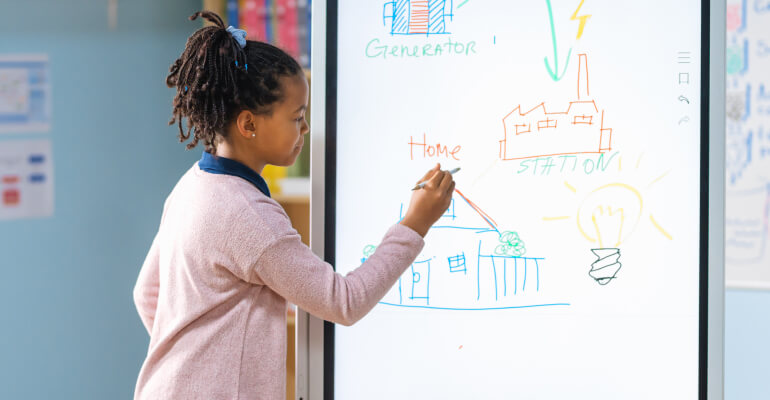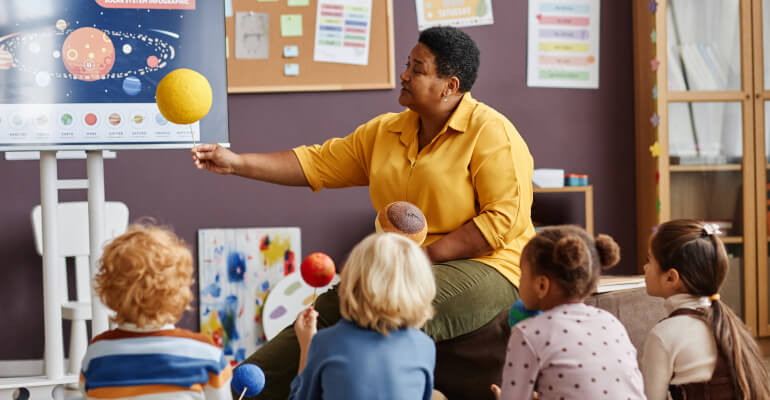Supporting visual learners in the elementary classroom is crucial for creating an inclusive and engaging STEM learning environment. By recognizing and implementing strategies that cater to their unique learning style, educators can empower their visual learning students and equip them with confidence around the STEM subjects.
By implementing strategies like visual cues and references, and holistic learning approaches, teachers can enhance comprehension, engagement, and overall learning outcomes.

Understanding Visual Learners
What is visual learning?
Among the diverse landscape of learning styles, an often overlooked group is visual learners. These are individuals whose most natural learning style is to interact with information visually, whether that’s with images, diagrams, graphs, or other visual representations of data. Research estimates that approximately 65% of individuals possess a strong inclination toward visual learning, however this percentage might be even higher due to a lack of self-assessment and awareness of our own learning styles.
Traditional educational settings often rely upon the practice of auditory instruction which misses the unique needs of visual learners. Once we recognize that such methods do not cater to all learners equally, it’s time to look for ways to support visual learners by fostering an inclusive, equitable, and effective learning environment for all learning styles—particularly in STEM.
What is the learning process like for visual learners?
Visual learners experience the learning process in a distinct way from their peers. Rather than auditory, memorization, or kinesthetic (hands-on, tactile learning) learning, visual learners succeed when there are many visual representations of the subject matter. They often recall facts or figures from visual images in their mind, and have a keen eye for details like colors, size, relative positioning, and ratios.
These learners posses a remarkable ability to retain and recall information that they perceive visually, so incorporating visual support in your lesson plans is extremely helpful for visual learning students.

How to Support Visual Learners in Elementary STEM Education
Overlooking the unique needs of visual learners can hinder their full potential and affect their confidence in STEM. By addressing their needs, educators can tap into their strengths and provide a more comprehensive and enriching learning experience for all their students.
To create an inclusive learning environment that supports visual learners, educators should integrate visual elements into the STEM curriculum. This might include visual aids, interactive materials, and well-designed instructional strategies.
- Visual Representation: Visual learners benefit from clear and tangible representations of concepts and ideas. Incorporate visual aids such as diagrams, charts, and infographics to enhance their understanding and retention of STEM concepts. These visual representations provide a concrete framework for visual learning students to grasp complex ideas and connect them to real-world applications.
- Interactive Learning Tools: Integrating interactive learning tools into your STEM instruction is essential for engaging visual learners. Utilize technologies like virtual simulations, interactive whiteboards, and graphic step-by-step guides with visual components to capture their attention and deepen their understanding of STEM principles. These tools provide opportunities for exploration, experimentation, and hands-on learning in a way that supports visual learners.
- Multimodal Learning Experiences: Visual learners thrive in multimodal learning environments that blend visual and auditory elements. Bring in multimedia resources like videos, animations, and presentations to engage their senses and reinforce the concepts they’re learning. By combining visual stimuli with auditory explanations, visual learners can build stronger connections of new STEM concepts.
Integrated STEM lesson plans also play a vital role in enhancing the learning experience of visual learners. In the following sections, we’ll explore more of these strategies in detail so you feel empowered to better support the visual learners in your class.

3 Ways to Support Visual Learners in the Classroom: Strategies for Engaging STEM Lesson Plans
When it comes to nurturing the minds of young learners, incorporating visual elements into your elementary STEM curriculum can make all the difference. You’ll find that the visual learners in your class thrive when provided with the right tools and teaching methods that align with their unique learning style.
By merging the power of visual with STEM instruction, educators can create an immersive and effective learning environment that resonates with visual learners and fosters their success in the STEM subjects.
Here are three different ways to support the visual learners in your classroom:
1. Introduce the Big Picture
Visual learners have a holistic approach to learning, so seeing the big picture upfront keeps them engaged and motivated to work toward the lesson plan’s finished product. By previewing the desired outcome at the beginning of each lesson, visual learners can better understand the purpose and context of each step. With this strategy, educators allow students to connect the dots and appreciate the significance of each step of the process.
For example, in an elementary STEM lesson plan by Kid Spark Education, we introduce the mechanical engineering concept of linear motion by having students build a simple machine that generates linear motion by the use of a rotary motion mechanism. To support visual learners, the step-by-step visual instructions conclude with an image of the final result so that students can see the completed mechanism and also understand each broken-down component that is built to create the final product.
2. Use Colors as Visual Cues
Visual learners are particularly receptive to color and symbol cues—making them especially effective tools for facilitating comprehension with visual learning students. One idea to support to visual learners in your class is to use specific colors to outline the different steps of a STEM lesson on the whiteboard, or use different colored tables or signs for different stages of a station-based lesson plan.
Using colors in this way helps create structure and order for visual learners so they can easily identify the different parts within the overall project. This visual organization acts like a visual container in which students can keep tasks and ideas organized. It helps in capturing attention and maintaining focus, bringing a sense of clarity that helps visual learners navigate through the lesson with confidence.
3. Post a Visual Reference
Whether it’s leaving an example of the final product on the screen, or writing out each stage or step of the lesson plan on the whiteboard, posting a visual reference in a prominent place in the classroom helps visual learners find their place throughout the lesson without getting lost or overwhelmed.
These references can take on various forms such as outlining each stage of the process, using post-it notes to help guide where the class is in the process, or by providing a visual anchor such as diagrams, written instructions, or pictures.
By implementing these strategies, educators can create a supportive environment that caters to the unique needs of visual learners in STEM education. Remember, every learner is different, so it’s important to adapt and customize these approaches based on your students’ individual preferences to best support them in their STEM journey. By embracing visual cues and providing clear visual references, educators can empower the visual learners in their class through the exciting world of STEM.

Explore STEM Lesson Plans with Kid Spark
At Kid Spark Education, we believe in inclusive and equitable access to STEM education for all learners. To meet the many types of learning styles, Kid Spark lesson plans and lab kits include a variety of ways for students to interact and engage with each hands-on learning experience.
Our labs are strategically designed for each age group, from Pre-K through middle school, so that students receive targeted, grade-appropriate educational tools. From here, we include reusable engineering tools that students grow familiar with throughout the many lessons and learning activities.
To support educators, we provide step-by-step instructions to guide your students through each lesson plan and even provide online professional development to build your own confidence in every STEM subject before presenting it to the class.

For visual learners at the elementary level, our STEM lesson plans provide colorful worksheets and instructions with activities that touch on many different learning styles. There are many types of learning styles, and we try to incorporate as many as possible in our comprehensive STEM lesson plans. This includes graphic illustrations, written instructions, oratory presentations of their original designs, and more.
If you’re interested in learning more about Kid Spark’s STEM labs for your classroom, contact us today.
.png?width=1270&height=453&name=Copy%20of%20Kid%20Spark%20Logo%20(Horizontal%20-%20Full%20Color).png)